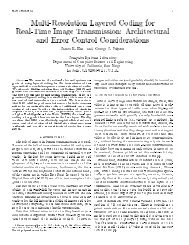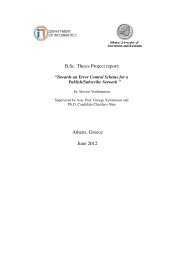In Network Processing and Data Aggregation in
In Network Processing and Data Aggregation in
In Network Processing and Data Aggregation in
You also want an ePaper? Increase the reach of your titles
YUMPU automatically turns print PDFs into web optimized ePapers that Google loves.
of communication failures because each read<strong>in</strong>g is accounted for <strong>in</strong> many paths towardsthe base station, <strong>and</strong> all would have to fail for the read<strong>in</strong>g to be lost. However, there aretwo drawbacks for the multi-path approach:(1) when many aggregates are to be accumulated, the known energy-efficienttechniques provide only an approximate answer (with accuracy guarantees), <strong>and</strong>(2) when some aggregates are to be accumulated, the message size is longer thanwhen us<strong>in</strong>g the tree approach, thereby consum<strong>in</strong>g more energy.(3) there is the danger to double count the same values because of the multipleparents.<strong>In</strong> the follow<strong>in</strong>g, it is proposed a protocol which recommends a topology called r<strong>in</strong>gs.<strong>In</strong> this topology, nodes are divided <strong>in</strong>to levels accord<strong>in</strong>g to their hop count from the basestation, <strong>and</strong> the multi-path aggregation is performed level-by-level towards the basestation.SYNOPSIS DIFFUSION [8]<strong>In</strong> [8] it is proposed a general framework for achiev<strong>in</strong>g significantly more accurate<strong>and</strong> reliable answers by comb<strong>in</strong><strong>in</strong>g energy-efficient multi-path rout<strong>in</strong>g schemes withtechniques that avoid double-count<strong>in</strong>g. Synopsis Diffusion uses a r<strong>in</strong>gs topology toperform <strong>in</strong>-network aggregation. The partial result at a node is represented as a synopsis,a small digest (e.g., histogram, bit-vectors, sample, etc.) of the data.The synopsis diffusion algorithm consists of two phases:a) a distribution phase <strong>in</strong> which the aggregate query is flooded through the network<strong>and</strong> an aggregation topology is constructed, <strong>and</strong>b) an aggregation phase where the aggregate values are cont<strong>in</strong>ually routed towardsthe query<strong>in</strong>g node.Distribution Phase<strong>In</strong> order to construct a r<strong>in</strong>gs topology, firstly, the base station transmits <strong>and</strong> any nodehear<strong>in</strong>g this transmission is <strong>in</strong> r<strong>in</strong>g 1. At each subsequent step, nodes <strong>in</strong> r<strong>in</strong>g i transmit<strong>and</strong> any node, apart from those that are already <strong>in</strong> a r<strong>in</strong>g, hear<strong>in</strong>g one of thesetransmissions, is <strong>in</strong> r<strong>in</strong>g i + 1. As a result, the r<strong>in</strong>g number def<strong>in</strong>es the level of a node <strong>in</strong>








